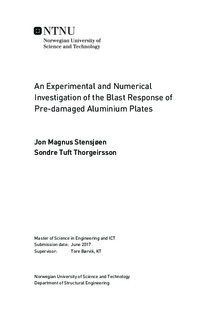| dc.contributor.advisor | Børvik, Tore | |
| dc.contributor.author | Stensjøen, Jon Magnus | |
| dc.contributor.author | Thorgeirsson, Sondre Tuft | |
| dc.date.accessioned | 2019-09-11T08:34:35Z | |
| dc.date.created | 2017-06-11 | |
| dc.date.issued | 2017 | |
| dc.identifier | ntnudaim:17688 | |
| dc.identifier.uri | http://hdl.handle.net/11250/2614883 | |
| dc.description.abstract | The dynamic response of thin, perforated aluminium plates subjected to blast load has been studied both experimentally and numerically. The experiments have been conducted in a shock tube facility, where the blast intensity is easily controlled through the initial conditions of each experiment. Four different perforation geometries were tested, with the goal of inspecting the influence the pre-formed holes had on the performance and failure of the plates. The plates had the blast-exposed area of 300x300 mm^2 with a thickness of 1.5 mm. Thin slit-perforations were cut into the plates, four plates with four slits and four plates with one slit. Each geometry was tested at both 10 bars and 15 bars of firing pressure. Four out of the eight plates experienced complete failure under the blast loads. The experimental results indicated signs of fluid-structure interaction (FSI) effects. Qualitative results in terms of picture series of the experiments are presented for comparison to numerical work.
The true stress-strain curve of the aluminium alloy AA6016 in T4-configuration was identified by uniaxial tensile tests where the behaviour was continuously measured to fracture. Material constants were found by direct calibration and inverse modelling in Abaqus. Additionally, the computer code NaMo were employed to obtain the true stress-strain curves of the material numerically. A NaMo material model was established based on the NaMo outputs. Simulations of the shock tube experiments employing the NaMo material parameters were compared to simulations with the material constants found from the tensile tests, with the goal of validating NaMo.
The main objective of the thesis has been to validate to which extent the response of the plates may be predicted using computational tools. Special attention was given to the crack propagation of the plates, and how well this could be recreated numerically. Lagrangian analyses were performed in Abaqus/Explicit to model the experiments. A preliminary numerical study found optimal values for different model parameters, including mesh size, boundary conditions and loading. The models proved sensitive to several parameters, especially mesh element size, element distribution and element type. The preliminary models were found to recreate the experimental results with good accuracy. Improvements were made to enhance the accuracy and reduce computational time, and final numerical models were established. The results from these simulations were validated against the experimental results. The simulations recreated the experiments with surprisingly high accuracy considering that Lagrangian analyses are one of the simpler methods to use for this problem. The NaMo material model was validated and proved to predict the material properties with good accuracy. | en |
| dc.language | eng | |
| dc.publisher | NTNU | |
| dc.subject | Ingeniørvitenskap og IKT, IKT og konstruksjonsteknikk | en |
| dc.title | An Experimental and Numerical Investigation of the Blast Response of Pre-damaged Aluminium Plates | en |
| dc.type | Master thesis | en |
| dc.source.pagenumber | 151 | |
| dc.contributor.department | Norges teknisk-naturvitenskapelige universitet, Fakultet for ingeniørvitenskap,Institutt for konstruksjonsteknikk | nb_NO |
| dc.date.embargoenddate | 2020-06-11 | |

